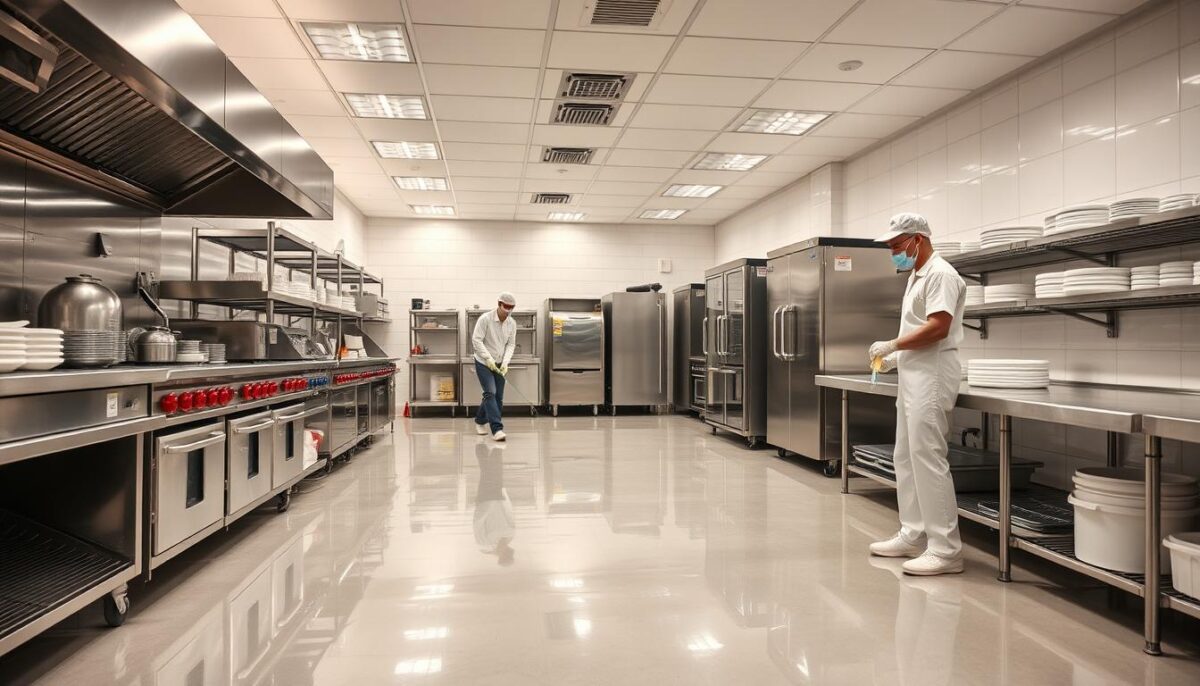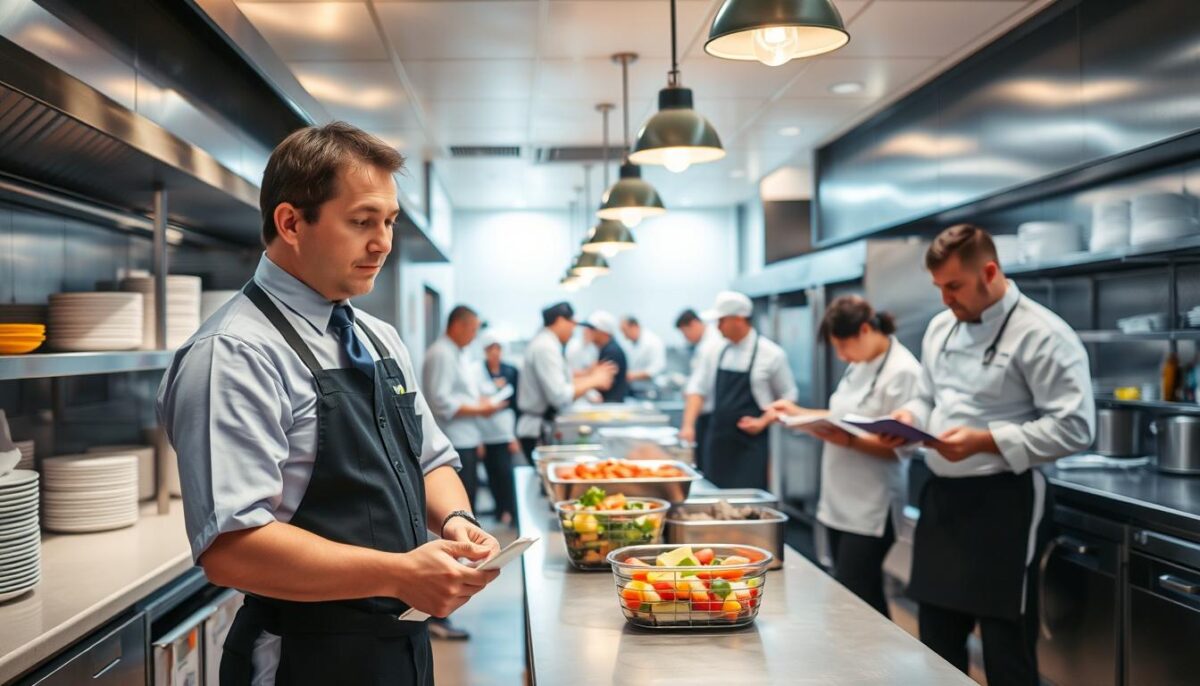
How Missing One Document Can Kill Your Restaurant Launch
August 31, 2025
Why Your Liquor License Is Delayed—and How to Fix It
September 1, 2025As a restaurant owner, I’ve experienced the stress of a surprise health inspection. The anxiety of potentially failing and facing the consequences can be overwhelming. Did you know that nearly 50% of restaurants fail their initial health inspection? This staggering statistic highlights the importance of being prepared.
In this guide, I’ll share a comprehensive checklist to help you pass your health inspection in just 60 minutes of focused preparation. With health inspections occurring unannounced 1-3 times a year, it’s crucial to be inspection-ready at all times.
By following this checklist, you’ll not only increase your chances of passing the inspection but also maintain a safe environment for your customers and staff. So, are you ready to take the first step towards a stress-free health inspection?
Key Takeaways
- Understand the importance of health inspections for your restaurant’s success
- Learn how to prepare for a health inspection in just 60 minutes
- Discover the essential items to include in your health inspection checklist
- Find out how to maintain a safe environment for your customers and staff
- Get practical tips on addressing common health inspection violations
Why Health Inspections Matter for Your Restaurant
As a restaurant owner, understanding the importance of health inspections is vital to maintaining a reputable and safe dining environment. Health inspections are a critical component of ensuring customer safety and satisfaction.
Health inspections serve as a crucial evaluation of a restaurant’s adherence to health and safety standards. Understanding the purpose of these inspections is essential to maintaining compliance and avoiding potential consequences.
Understanding the Purpose of Health Inspections
The primary purpose of health inspections is to ensure that restaurants maintain a safe and healthy environment for customers. This includes evaluating food handling practices, kitchen cleanliness, and staff hygiene.
By understanding the purpose of health inspections, restaurant owners can take proactive steps to maintain compliance and provide a safe dining experience.
The Consequences of Failed Inspections
Failed health inspections can have severe consequences for restaurants, including financial penalties, damage to reputation, and even temporary closures. Some of the potential consequences include:
- Financial penalties that can impact your bottom line
- Damage to your restaurant’s reputation, especially in the age of online reviews
- Temporary closures resulting in lost revenue and customer trust
- Costly corrective actions, staff retraining, or equipment replacement
- Increased insurance premiums for establishments with poor safety records
Moreover, the most serious consequence is the potential harm to customers if food safety standards aren’t maintained.
Preparing Your Restaurant for a Health Inspection
Preparing for a health inspection requires a proactive approach. This involves several key steps to ensure your restaurant is compliant with health regulations.
Creating a Pre-Inspection Schedule
To stay on track, create a pre-inspection schedule that outlines regular checks and maintenance tasks. This schedule should include daily, weekly, and monthly tasks to ensure your restaurant remains compliant with health codes. For example, daily tasks might include checking food temperatures, while weekly tasks could involve cleaning equipment and monthly tasks might encompass thorough self-inspections.
Training Your Staff on Health Code Requirements
Training your staff is crucial for a successful health inspection. Employees should be educated on proper food handling, sanitation procedures, and how to respond to questions from health inspectors. Regular training sessions can help reinforce these practices and ensure staff are up-to-date on the latest health code requirements.
Conducting Self-Inspections Regularly
Regular self-inspections are vital to identifying and addressing potential issues before the official health inspection. This involves conducting thorough checks of your restaurant, documenting findings, and implementing corrective actions as needed. Rotating inspection responsibilities among managers and involving staff from different areas can provide fresh perspectives and help identify potential violations.
| Inspection Area | Frequency | Responsible Staff |
|---|---|---|
| Food Temperature Checks | Daily | Kitchen Staff |
| Equipment Cleaning | Weekly | Maintenance Team |
| Self-Inspections | Monthly | Managers |

By following these steps and maintaining a proactive approach, your restaurant can be well-prepared for a health inspection, reducing the risk of violations and ensuring a positive outcome.
Essential Restaurant Health Inspection Checklist
To ace a health inspection, it’s essential to understand the key requirements and standards. A comprehensive checklist can help ensure your restaurant is well-prepared for the inspection.
Food Temperature Control Requirements
Maintaining proper food temperature is critical for preventing foodborne illnesses. I ensure that my restaurant adheres to the required temperature controls for cooking, holding, and receiving food. This includes keeping accurate temperature log records for all food processes.
| Food Process | Required Temperature |
|---|---|
| Cooking | 165°F (74°C) |
| Holding | 145°F (63°C) |
| Receiving | 40°F (4°C) or below |
Food Storage and Handling Standards
Proper food storage and handling are crucial for maintaining a safe and healthy environment. My restaurant follows strict guidelines for storing food, including labeling and dating stored food. We also have a reliable system for managing our food supplies, ensuring that all food is handled and stored correctly.
- Labeling and dating stored food
- Storing raw meat, poultry, and seafood separately
- Maintaining a clean and organized storage area
Documentation and Record-Keeping
Accurate documentation and record-keeping are vital for demonstrating compliance with health regulations. I ensure that my restaurant maintains detailed records, including temperature logs, cleaning schedules, and employee training records. We also have a comprehensive HACCP plan in place, which is regularly reviewed and updated.
By maintaining accurate and detailed records, my restaurant can demonstrate its commitment to food safety and compliance with health regulations.
Employee Hygiene and Personal Practices
Maintaining employee hygiene and personal practices is crucial for a restaurant’s overall health and safety standards. As a restaurant owner, it’s essential to implement policies that ensure employees maintain high levels of personal hygiene and adhere to health guidelines.
Proper Handwashing Techniques
One of the most critical aspects of employee hygiene is proper handwashing techniques. Employees should be trained to wash their hands thoroughly with soap and warm water for at least 20 seconds, especially after handling food, using the restroom, or touching animals. Proper handwashing is key to preventing the spread of illnesses.
Dress Code and Personal Protective Equipment
Implementing a strict dress code and using personal protective equipment (PPE) are vital for maintaining hygiene standards. Employees should wear clean uniforms and aprons, and use gloves when handling food. Hair should be tied back, and jewelry should be minimal to prevent contamination. Using PPE correctly can significantly reduce the risk of food contamination.
Health and Illness Policies
Having clear health and illness policies in place is crucial for preventing the spread of communicable diseases. Employees should be encouraged to report any symptoms of illness, and those showing symptoms should be excluded from food handling duties. Paid sick leave policies can encourage employees to report their illnesses honestly, reducing the risk of spreading diseases in the restaurant.
By implementing these measures, restaurants can significantly improve their health and safety standards, ensuring a cleaner and safer environment for both employees and customers.
Facility Maintenance and Cleaning Standards
To achieve a high health inspection score, restaurants must focus on facility maintenance and cleaning standards. This involves ensuring that all areas of the restaurant, from the kitchen to the dining area and restrooms, are clean and well-maintained.
Kitchen Equipment Sanitation
Proper sanitation of kitchen equipment is critical to preventing the spread of bacteria and other contaminants. This includes regularly cleaning and sanitizing equipment, such as ovens, stoves, and refrigerators. I recommend creating a schedule to ensure that all equipment is cleaned and sanitized regularly.
| Equipment | Cleaning Frequency | Sanitizing Method |
|---|---|---|
| Ovens | Daily | High-temperature wash |
| Stoves | Daily | Degreaser and sanitizer |
| Refrigerators | Weekly | Mild detergent and sanitizer |
Dining Area and Restroom Cleanliness
The dining area and restrooms must also be kept clean and tidy to ensure a positive customer experience and to prevent the spread of illness. This includes regularly cleaning tables, chairs, and floors, as well as ensuring that restrooms are stocked with soap, toilet paper, and paper towels.

Pest Control Measures
Effective pest control measures are essential to preventing pest infestations in restaurants. This includes sealing any cracks or holes to prevent pests from entering, maintaining clean and tidy dumpsters, and regularly inspecting for signs of pest activity. I recommend working with a licensed pest control operator to implement regular preventive treatments.
- Seal all cracks and holes to prevent pest entry
- Maintain clean and tidy dumpsters
- Regularly inspect for signs of pest activity
By focusing on facility maintenance and cleaning standards, restaurants can ensure a clean and safe environment for customers and staff, ultimately achieving a high health inspection score.
What to Do During the Health Inspection
Interacting with the health inspector in a professional manner is vital during the inspection. As a restaurant owner, your cooperation and transparency can significantly impact the outcome of the inspection.
How to Interact with the Health Inspector
When the inspector arrives, greet them courteously and provide the necessary documentation. Be prepared to accompany them during the inspection, answering questions and providing access to all areas of your restaurant.
Addressing Violations On the Spot
If the inspector identifies any violations, it’s essential to address them promptly. Ask for clarification on any issues you don’t understand, as this will help you correct the problems effectively.
Understanding Your Inspection Report
After the inspection, review the report carefully. Understand the difference between critical and non-critical violations, and the impact they have on your overall score.
| Violation Type | Description | Impact on Score |
|---|---|---|
| Critical Violations | Serious infractions that directly affect food safety | High |
| Non-Critical Violations | Minor infractions that don’t directly impact food safety | Low |
Sign the inspection report to acknowledge receipt, not to indicate agreement with the findings. Use the report as a tool to improve your restaurant’s health and safety standards.

Conclusion: Maintaining Compliance Year-Round
A well-prepared restaurant is not just about passing health inspections; it’s about creating a culture of food safety. To achieve this, it’s essential to integrate health code compliance into your daily operations. This involves ongoing staff training and regular self-assessments to ensure that your establishment maintains high standards year-round.
By doing so, you can improve customer confidence and reduce the risk of food-borne illnesses. Staying updated on changing health code requirements and food safety best practices is also crucial. With proper systems in place, passing health inspections becomes routine rather than stressful.
Ultimately, food safety is about protecting your customers and maintaining a successful restaurant business. By following this guide, you can confidently pass health inspections in just 60 minutes of focused preparation. This not only ensures a smooth inspection process but also reinforces your commitment to service excellence and HACCP principles.
FAQ
What is the purpose of a health inspection?
The primary goal of a health inspection is to ensure that my establishment is maintaining a clean and safe environment for customers, thereby preventing the risk of foodborne illnesses.
How often are health inspections conducted?
Health inspections are typically conducted at least once a year, but the frequency may vary depending on the local health department’s policies and my establishment’s compliance history.
What are some common violations cited during health inspections?
Common violations include improper food temperature control, inadequate handwashing practices, and poor pest control measures. I make sure to address these areas proactively to avoid citations.
Can I prepare my staff for a health inspection?
Yes, I train my staff on health code requirements, including proper handwashing techniques, food handling practices, and cleaning protocols, to ensure they are prepared for a health inspection.
What happens if I fail a health inspection?
If I fail a health inspection, I receive a report outlining the violations and the necessary corrective actions. I must address these issues promptly to avoid further penalties or even establishment closure.
How can I maintain compliance year-round?
To maintain compliance, I conduct regular self-inspections, maintain accurate records, and stay up-to-date on food safety regulations and best practices, ensuring my establishment remains a safe and healthy environment for customers.
What is the role of a health inspector?
A health inspector evaluates my establishment’s compliance with local health codes and regulations, identifying potential hazards and providing guidance on corrective actions to ensure a safe food service environment.
How can I ensure proper food storage and handling?
I store food at the correct temperatures, label and date products, and train my staff on proper handling practices to prevent cross-contamination and ensure food safety.



